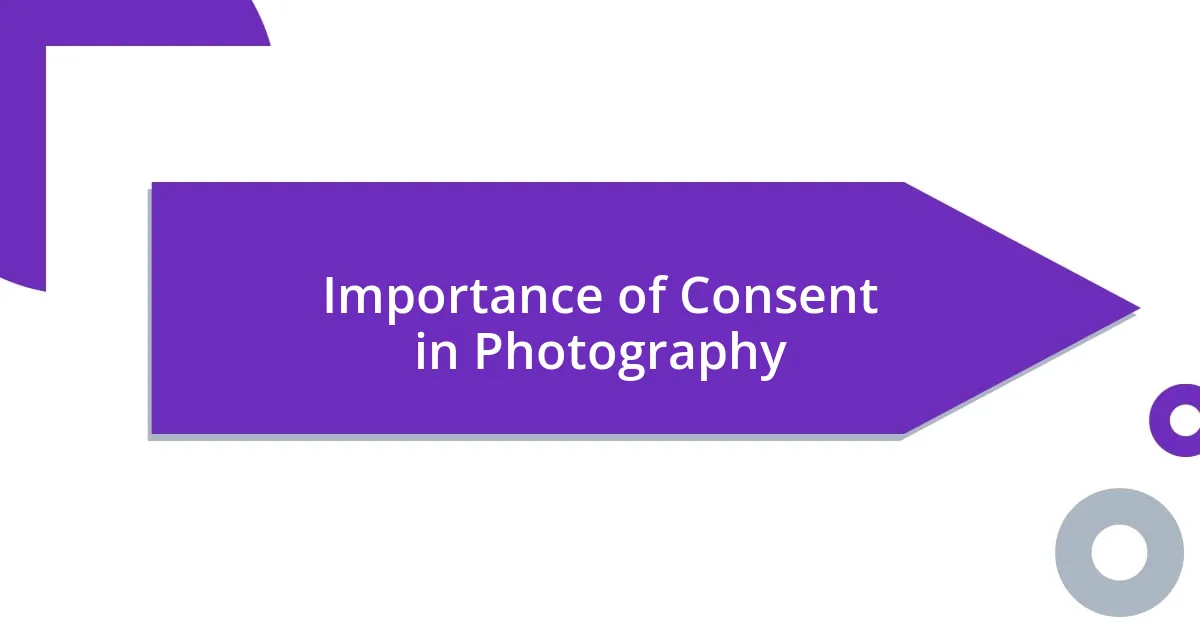Key takeaways:
- Ethical photography requires respect and responsibility, emphasizing the importance of consent and transparency with subjects.
- Understanding cultural sensitivities and the nuances of different communities is vital to fostering genuine connections and avoiding misrepresentation.
- Engaging with subjects and understanding their narratives leads to richer storytelling, breaking down stereotypes and offering deeper representation.
- Ongoing education in ethical practices is essential for photographers to refine their approach and recognize the impact of their work on communities.

Understanding Ethical Photography Practices
Understanding ethical photography practices is about more than just skill; it hinges on respect and responsibility. When I first stumbled into photography, I found myself capturing beautiful images of people in vulnerable situations. Looking back, I realize that I often didn’t consider how my presence—or the resulting images—might affect them. Isn’t it crucial to ask ourselves how we can honor the subjects we photograph rather than just seeing them as a means to an end?
I believe that ethical photography requires transparency, especially when sharing images that feature people or communities. I vividly remember a time when I sought permission from a stranger before taking their portrait, and what started as a quick snapshot turned into a meaningful conversation. We both left that encounter feeling empowered—me for respecting their space, and them for being acknowledged. Shouldn’t every photographer strive for that same sense of connection in their work?
Additionally, the concept of consent plays a pivotal role in ethical photography. Taking a moment to think about the implications of sharing someone’s image can be powerful. After all, how many times have we come across a photo that raised more questions than it answered about the subject’s context? By ensuring that we’re capturing and sharing images responsibly, we not only elevate our craft but also foster trust and understanding within the communities we explore.

Importance of Consent in Photography
Obtaining consent in photography is not just a legal formality; it’s a profound acknowledgment of the subject’s agency. I recall a project where I photographed a local event. Before snapping any images, I asked participants if they were comfortable being photographed. The positive responses I received not only enriched my portfolio but also built a rapport with the community. That simple act of asking made everyone feel valued and respected, transforming the experience for both sides.
Here are some key reasons why consent is vital in photography:
- Respect for Individual Rights: Every person has the right to control their image and how it’s shared.
- Building Trust: When you seek permission, it fosters a sense of trust between you and your subjects.
- Empowerment: Individuals feel empowered when they can choose whether or not to share their likeness.
- Nurturing Relationships: Respecting consent can lead to deeper connections with your subjects and richer storytelling.
- Cultural Sensitivity: Different cultures have varied perspectives on image sharing; understanding this enhances respectful interactions.
Emphasizing consent offers an enriching layer to the photographic process, reminding us that beyond every photo is a person with their own narrative and feelings.

Respecting Privacy in Public Spaces
It’s fascinating how respecting privacy in public spaces can reshape our understanding of ethical photography. I once found myself at a bustling street fair, where the vibrant atmosphere begged for candid shots. While many people were absorbed in their celebrations, I had to pause. In that moment, I realized that my desire to capture the joy around me had to align with the rights of others to maintain their privacy. Just because a moment is public doesn’t mean it’s fair game. It’s about finding that balance between artistic expression and respect for individuals’ boundaries.
There’s a misconception that photographers can shoot freely in public spaces without considering the implications. I remember chatting with a fellow photographer who proudly shared a striking shot he had taken of a child playing at a park. He seemed oblivious to the potential discomfort that image could cause the child’s parents. This moment made me reflect on how important it is to be aware of our surroundings and the lives we intersect with. People deserve dignity, even in public; that’s a lesson I carry into every shoot.
Navigating the fine line between public and private can be complex. I often ask myself, “What if the tables were turned? How would I feel if I noticed someone filming my family?” This question shapes my approach to photography. It emphasizes sensitivity, reminding me that, despite the communal nature of a public space, there’s a spectrum of personal comfort. Each person’s narrative is their own, and acknowledging that helps us create a more respectful photographic practice.
| Aspect | Private Space | Public Space |
|---|---|---|
| Expectation of Privacy | High (e.g., homes, private events) | Lower (e.g., streets, parks) |
| Consent Requirement | Always Needed | Generally Not Required, but Should be Considered |
| Emotional Sensitivity | Critical | Still Important |

Cultural Sensitivity in Photography
Cultural sensitivity in photography is vital, especially when working in diverse environments. During a trip to a rural community, I learned the importance of awareness. I approached a group preparing for a traditional ceremony, and instead of immediately raising my camera, I offered them context about my intentions. Their smiles and eager willingness to share their culture felt like an intimate exchange, reminding me that photography is more than just capturing images; it’s about honoring traditions and fostering mutual respect.
I often ask myself, “How would I want someone to depict my culture if the roles were reversed?” This question shapes my approach significantly. For instance, while photographing a dance performance, I couldn’t help but notice the intricate patterns in the performers’ attire. I sought permission to capture their movements, carefully addressing each individual. The excited reactions were affirming—showing me that when you treat cultural symbols with reverence, it leads to powerful storytelling. A respectful perspective opens doors, not just to candid moments but to genuine connections.
We must recognize that every culture has its nuances. I recall photographing a gathering celebrating a local festival. While I was eager to document the colorful displays and joyful faces, I remembered hearing stories of how some communities feel misrepresented through imagery. This understanding shifted my focus; rather than framing an image for my own benefit, I aimed to capture the essence of the event as they saw it. It made me appreciate the weight of cultural representation, internalizing that thoughtful engagement fosters a richer photographic experience for everyone involved.

Managing Representation and Stereotypes
Managing representation and stereotypes in photography is an ongoing challenge that I constantly navigate. I remember attending a photo exhibition featuring images of marginalized communities. Although the photos were visually striking, I felt uneasy knowing that many of the subjects were portrayed through a shallow lens, reinforcing stereotypes instead of celebrating their depth. It made me consider how the stories behind the images are often overlooked; a single photograph has the power to shape public perception, and that responsibility weighs heavily on my shoulders.
When I’m out in the field, I’m always conscious of the narratives I choose to capture. One afternoon, I found myself photographing a group of teenagers hanging out in their neighborhood. Initially, I felt tempted to frame them in a way that aligned with common stereotypes of youth culture. However, as I spent time with them, their shared laughter and dreams emerged, painting a much richer picture of who they truly are. It reminded me that representation should not just be about what the lens sees; it’s about portraying the multifaceted identities people hold.
Engaging with the communities I photograph is crucial for managing the impact of representation. I often ask myself, “How would I feel if someone captured my story without understanding its context?” This reflection has led me to engage in conversations with my subjects, ensuring I understand their perspectives before I click the shutter. By valuing their voices, I contribute to breaking down stereotypes rather than reinforcing them. Through this approach, I believe we can create imagery that respects the complexity of human experience, giving each individual the voice they deserve.

Best Practices for Ethical Storytelling
When I think about ethical storytelling in photography, I often recall a moment in a bustling market where vibrant interactions unfolded around me. Instead of simply snapping away, I took a moment to engage with a local vendor, learning about the stories behind his craft. This experience reminded me that the best stories come from genuine connections; it’s essential to understand the larger narrative before portraying someone’s image, allowing for a richer and more respectful representation.
There was a time I photographed a community gardening project that brought together people from various backgrounds. Initially, I was excited to capture the vibrant plants and hardworking hands. However, I quickly realized that the heart of the story lay in the relationships being cultivated among the participants. It struck me that focusing solely on the visuals would miss the essence of what was happening—people were building trust, sharing experiences, and promoting unity. This understanding shifted my approach to storytelling, placing emphasis on the shared experiences that define a community.
Another pivotal moment occurred when I was invited to document a family reunion. Instead of just arranging posed shots, I allowed the interactions to guide my framing. I found myself capturing candid moments of laughter, shared memories, and even the occasional tear. I remember thinking, “How would I want my family’s story told?” This reflection shaped my approach, ensuring that the final images not only depicted faces but also conveyed the emotions and connections that define family bonds. In doing so, I felt the responsibility of ethical storytelling deeply; it’s about honoring the truth of each experience, rather than casting it into a narrow narrative.

Continuing Education on Ethical Photography
Continuing education in ethical photography is essential for every photographer who seeks to grow in this field. I’ll never forget attending a workshop on cultural sensitivity, where we discussed the potential negative impacts of photography on vulnerable communities. Was I aware of the weight my images could carry in shaping narratives? That experience opened my eyes to a crucial reality: ongoing learning isn’t just a checkbox; it’s a lifelong journey.
I often seek out educational resources, such as online courses and reading materials that focus on ethical practices. Recently, I took part in an online seminar centered around consent and privacy, which really challenged my understanding of how I interact with my subjects. It made me think about the importance of continual reflection—after attending these sessions, I often ask myself, “Am I creating a safe space for my subjects?” This question has become a guiding principle in my work.
Connecting with other photographers by joining ethical photography groups has also been a game-changer for me. Engaging in discussions about our experiences not only broadens my perspective but also reminds me of the power our craft holds. It’s fascinating to learn how others approach ethical dilemmas. I always leave those meetings inspired and eager to put new ideas into practice, continuing to grow and refine my approach to ethical photography every day.












